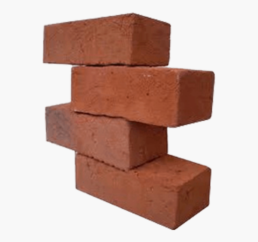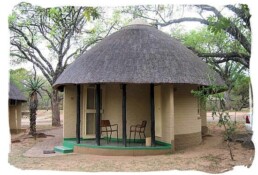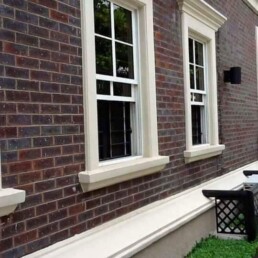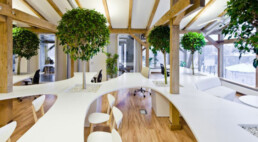BRICKS BY SHAPES
In the history of professional construction practices, brick is one of the oldest of all building materials. It is also arguably the most durable since there are brick walls, foundations, pillars, and road surfaces constructed thousands of years ago that are still intact. Today, bricks are most often used for wall construction, especially as an ornamental outer wall surface.
Brick Defined
Officially, the term brick is used to denote a building unit made of shaped clay, but in modern times it is used to refer to any stone- or clay-based building unit that is joined with cementitious mortar when used in construction. Typically, bricks are about 4 wide, 8 inches long, with a variety of thicknesses. Larger stone- or clay-based building units of the type used in foundations are usually called blocks.
How Bricks Are Categorized
There are several ways that brick can be categorized. For example, you can divide brick into the types used for facing (exposed and visible on the exterior of a structure) vs. backing bricks (which are used structurally and are hidden from view). Another means of categorizing brick is according to how they are manufactured: unfired (brick that is air-cured) and fired (brick that is baked in ovens to harden it). Bricks can be also categorized according to their typical use: common bricks or engineering bricks. For purposes of residential construction, it is usually common bricks that are of most interest, since engineering bricks are more often used in civil engineering projects, such as road or bridge construction, or sewers construction.
Bricks can also be categorized according to their shape. Some common shapes include:
- Brick veneers: These bricks are thin and used for surface cladding.
- Airbricks: These bricks contain large holes to circulate air and lessen weight. They are used on suspended floors and cavity walls.
- Perforated bricks: These bricks contain many cylindrical holes drilled throughout the brick. They are very light in weight.
- Bullnose brick: These are bricks moulded with round angles.
- Paving bricks: These bricks contain a good amount of iron. They are used in underfoot paving applications.
- Capping bricks: These bricks are used to cap the tops of freestanding walls.
- Hollow bricks: About one-third of the weight of the normal bricks, these are used mostly in partition walls where load-bearing is not required.
The African hut
A hut is a building of a lower quality than a house (durable, well-built dwelling) but higher quality than a shelter (place of refuge or safety) such as a tent and is used as temporary or seasonal shelter or in primitive societies as a permanent dwelling.
The hut in the 21st century
Although huts still exist in poor, mostly rural Africa, one could safely argue that they are a thing of the past; that these structures have been overtaken by technology and modernization. However, due to their benefits, like natural air conditioning, serenity and tranquility, the hut has found its way into the modern age.
Huts are not only environmentally friendly but also economically sound. A grass-thatched house is cool and when you drink water kept in a pot, it is as cold as water from the fridge,
The re-emergence of the hut stems from the increasing temperature in Africa due to global warming. In order to attract clients, hotels and luxury pubs have adopted a grass-thatched style for their cottages and bars. Huts are very comfortable. This is mainly because of the building materials used. Both clay and grass are good insulators, but they are porous and allow a free flow of air.
It is often very hot during the afternoons in Africa. The hut remains cool and is a welcome resting place. At night, when temperatures fall, the hut retains its daytime temperature, keeping the inhabitants warm.
The question of whether the re-appearance of huts in Africa and beyond is a positive development or a sign of Africans not letting go of their “primitive” past is indeed a question that can be debated.
Automatic Sliding Doors
Automatic sliding doors are designed with attractive framing and sleek styles to complement any entry. Glass sliding doors are ideal when it comes to unobstructed views and allowing natural light into a building.
Where possible for building entrances, use automatic sliding doors activated by a motion detector. These doors also provide an audible cue for people impacted by blindness to the presence of the entrance. Automatic sliding doors don’t impede traffic flow in any way, don’t require guardrails for protection (as automatic non-sliding doors do) and are universally accessible.
If there’s an emergency or power loss, it should be possible to open automatic sliding doors in the direction of exit using a manual force of 66 N or less.
Overhead motion activated sensors are preferred over floor-pad door activation sensors, as the floor-pads are prone to malfunction in winter. If floor-pad door activation sensors are used, they should be installed with the surface of the pad no more than 13 mm above the surrounding ground surface.
If push buttons are used for automatic swing-type doors, each button should open only one door. Push buttons should never open both leaves of a pair of doors. A person should be able to open or stop an automatic swing-type door with a force of 66 N or less.
Where used, push-button or push-plate activated power door operators should be consistently located at all entrances. They should be colour contrasted to the background environment to enhance visibility for people impacted by blindness. Position push buttons/plates so that the opening door doesn’t hit the person opening the door or their guide dog.
Characteristics and Advantages
(1) Automatic sliding door mechanism are available in either single sliding, bi-parting or telescopic configurations.
(2)Modularization design to make installation and adjust more easy;
(3)Adaptable to all types of door frames;
(4)Motor power control system with automatic reversal for user safety;
Automatic Sliding Door System using:
1) 10mm Toughened (Tempered) Frameless Glass Door with Logo Design on Door
2) 5mm Aluminium Framed Glass Door
* Door sizes can be customized
More Powerful
Three roller carriage ensure the door can’t derail from the profile.
European installation design promise its smooth and stable operating.
Rubber damping-washer, advanced synchronous toothed belt and alloy guide roller make sure there is few noise when it works.
Hands free operation is actuated by sensor activation or other automatic activation.
The various operating modes “ Lock, Exist Only, Permanent Open, Half Open, Automatic” can be selected via remote activation ( remote controller).
Unique design remote controller.
When you don’t need to use remote controller, you can power off to increase its working life
Safe Operation
Safety beam sensor protection
Auto-reverse when it meets obstruction. The impact force is less than 67N.
Easy to open by hand after power fails.
It can open at least 80% within 3s after activation by activators if opening width is up to 2000mm.
Battery works after power fails. Door open and keep open or works normally with battery power.
Fuse protection
SOUTH AFRICAN BURNT BRICKS IN Nigeria
The South African bricks does not require any form of polishing to gloss it or any superficial sealant as the brick material has attractive sheen on its own without adding any extra polish on it.
South African brick tiles are veneer burnt bricks made from the fry ash technology of brick manufacturing, then sliced into thin brick tiles and thereafter fired in large hot kilns or ovens. Many builders and home owners in Nigeria make use of the South African brick tiles for both interior and exterior wall decorations where the bricks are cladded on the wall with adhesive mortars to give buildings aesthetic look and feel. Each piece of South African brick tile measures 220mm in length by 70mm in width with a thickness of about 9mm.
South African bricks are sometimes referred to as burnt bricks, burnt red bricks or fired bricks here in Nigeria. This is because of it's burnt feel and appearance. The final colors of the south African bricks depend on the type of iron pigment additive added to the fly ash mixture during the bricks manufacturing process. The colors of South African bricks in Nigeria include Shiraz which is very dark coffee brown, merlot which is also dark brown, duet, burnt jasper, ivory, satin and the rest are all lighter shades of south African bricks.
Many builders buy South African bricks in Nigeria usually because of the natural burnt feel it comes with and the resultant aesthetic look it yields on the building wall. This does not mean that using south African bricks is an automatic transfer of aesthetics on any building it is used on. You need to plan out the portions of the building where to lay the south African bricks for best effects.
PRICE OF SOUTH AFRICAN BRICKS IN NIGERIA
The price of South African bricks ranges from N6,200 per carton to N6,500 per carton where one carton gives one square meter of bricks when installed with a consistent gap of 12mm in between the bricks and each carton contains 50 to 52 pieces of individual brick tiles depending on how the company packages it from South African. The price of south African bricks given above does not include installation or transportation costs to your building site, brick installers in Lagos usually charge between N900 to N1,000 per square meter for brick installations or brick laying within Lagos per square meter.
Office trees
Trees not only provide beautiful imagery and fond memories, they also enable the momentary escape for building inhabitants who spend most of their waking lives indoors, shut off from nature. Trees are synonymous with life and belong in the workplace as much as laptops and desks. Studies have shown that by having abundant plant life in the office, employees are more productive and less stressed.
It is hard to envision a more soothing and impressive sight than a three-story tree next to a winding staircase in a corporate lobby. The impact is immediate. In the workplace, office trees offer needed color and life to an otherwise dull expanse of wasted space. They evoke joyful memories of yesteryear and all the wonders of nature. There are a wonderful variety of tree species that will thrive indoors.
- Ficus trees such as a weeping fig or the Indian rubber plant, are but two of more than 800 species of ficus. They are tropical trees that are durable and thrive indoors with minimal TLC. They are excellent natural filters of indoor pollutants and are simultaneously easy on the eyes as well as the lungs.
- Large Palm Trees like the Mediterranean Fan Palm can reach a height of 15 feet. It’s a compact clump forming palm that is as aesthetically pleasing and rugged enough for indoor planting or as a potted gem.
- Bamboo Trees can grow to a height of 16 to 20 feet and are ideal for indoors as they are resistant to dry environments as long as proper care is taken. they favor shade and their leaves vary from gray and green to cream and green. Bamboo trees provide cover and privacy particularly in shopping malls and other indoor places where people tend to gather.
The benefits of indoor trees
Trees in the office remove indoor pollution naturally. Plant life can also lower heating and cooling costs. Trees moderate the climate while improving air quality. Leaves filter the air that we breathe by removing dust and other particulates, while giving off oxygen. An EPA study in Chicago showed that the 23.2% of canopy cover in the Lincoln Park neighborhood annually filters 43.9 tons of particulate matter, 14 tons of carbon dioxide and 12.4 tons of nitrogen oxides, leading to an estimated pollution abatement of $625,000 per year.
Trees and plants in the office are used to reduce background noise. Research has shown that plants can also reduce background noise levels by up to 5 decibels. Through absorption, diffraction and reflection of background noise, trees and other plants in the office create a more comfortable and quiet work environment. Greenery placed in the corners and along the edges is the best way to maximize noise absorption.
The numerous benefits of office trees and other indoor trees include complimenting other features of a building, cleaning the air of toxins, reducing noise, providing a soothing effect to occupants while increasing the value of the property and ROI (Return On Interior).
Choosing Brick Wallpaper
Factors to Consider When Choosing Brick Wallpaper
Here are some few things you to need to pay attention to when selecting brick wallpaper for your interior design:
The very first thing that you will need to consider when selecting brick wallpapers for your interior design is your space. Depending on your preferences, you will need to go for the right wall so that your rooms can pop to their full potential. It is critical for you to consider the space so as to select the best possible location for your brick wallpaper application. This will help you tie the room together seamlessly.
Speaking of your space, another important thing that you need to consider is the layout of the room. If your room has a shape similar to that of a cone-head, it will be hard to erect a brick wallpaper. In addition to this, you should also take into consideration other pieces of art that might consume all space required for your wallpaper. In simple terms, if you are only able to see 15% of your brick wallpaper, is it worth having it on your wall?
- What do you want to make standout
What do you want to achieve with your brick wallpaper interior design? Brick style wallpaper can be installed in a dining room so as to highlight a china filled armoire or wooden table. In your living, you can apply brick effect wallpaper so as to emphasize the look of your leather sofa and other décor pieces you have. Additionally, you could also install brick wallpaper so as to boost the look of your office or fireplace, at home.
To get the best possible appeal out of a brick wallpaper design, ensure that you install it on surfaces that are undisturbed by doors or windows. Also, note that different rooms require a different wallpaper design and style. For instance, a brick wallpaper bedroom design should be moisture-resistant while a kitchen wallpaper ought to be stainless and washable.





